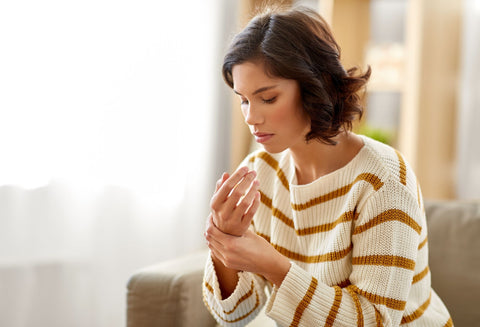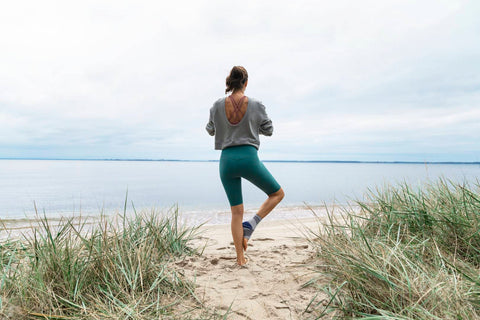Why do joints hurt more when it's cold or damp?

Unfortunately, the exact reason isn’t known, but researchers and medical specialists alike have outlined a few potential causes.
We are less active in winter.
When managing osteoarthritis and rheumatoid arthritis pain, exercise is one of the best remedies. It keeps the muscles strong so they can support the joint better. It also helps reduce the muscle stiffness associated with the condition. And it keeps essential nutrients circulating into avascular cartilage (this being cartilage that doesn’t have a blood supply and thus relies on movement and pressure to stay healthy.) So, because you move less, your joints could hurt more.
Minor structural changes are happening in the joint in cold weather.
Specifically, one study notes that synovial fluid tends to become more viscous in cold weather. Every joint has little sacks called bursae, which contain this fluid. The sacks are positioned between bony protrusions and other softer tissues to stop them from rubbing against each other. Synovial fluid, meanwhile, helps lubricate the joint. When the fluid thickens, it could lead to less smooth joint movement and more friction between bones and soft tissues like tendons.
The same study also suggests that dramatic drops in air pressure (such as before a storm) cause joints to expand, potentially leading to a feeling of achiness. This effect will be more pronounced in people with more advanced osteoarthritis and rheumatoid arthritis. As cartilage degenerates, the joint has less space for the tissues to expand into, making them agitated.
The cold heightens our sensitivity, making pain seem more pronounced.
When it’s cold, our pain receptors grow more sensitive. Hence, you may technically feel the same pain but register it as worse.
Cold weather restricts blood flow
The cold makes blood vessels constrict, impacting your circulation. Since the muscles and other joint tissues get less oxygen and nutrients, they can stiffen up and even become painful.
Remedies for joint pain in winter
Stay warm
The first and most obvious way to combat joint pain in winter is to stay warm. The NHS recommends keeping your house at 18 degrees Celsius, minimum.
You should also try dressing in thermal clothes, as they are much better at trapping body heat and don’t require a lot of extra, heavy layers overtop.
If your joints are still complaining after a freezing day out, get on top of an electric blanket or into a warm bath.
Stay active
Physical activity is a great way to get the blood pumping and reduce muscle stiffness. And as we mentioned, it’s also the best way to strengthen your muscles and ensure they can adequately support your joints (both true of injury and arthritis).
If you don’t want to exercise outdoors, you can:
- Swim at an indoor pool
- Walk on a treadmill or ride a stationary bike at home or the gym
- Take a couple of yoga or Pilates classes
- Or even just do some exercises at home.
Remember, when it comes to arthritis, gentle exercise that gets you moving without putting excess strain on the joint is best. We’ve compiled some exercises you can try for knee, wrist, ankle, and back pain.
Alternatively, download the Bauerfeind training app on the App Store or Google Play for a tailored exercise program.
Try a brace
GenuTrain
Medical-grade braces are a good fit for joint points - both in the cold and otherwise.
- The compression knit fabric in braces like our ManuTrain, GenuTrain, and LumboTrain boosts circulation, keeping your joints warm and easing muscle tension.
- It also activates the muscles, helping them better support and protect the joints. Joint pain can often intercept other nerve signals, preventing muscle fibres from working properly. Bad signal reception can lead to bad proprioception, as your brain can’t accurately tell how to move or place a given joint. And as the joint stops tracking properly, you may get more pain as a result.
- Compression knit is also known to reduce the production of edemas, your body’s inflammatory agents. This can reduce swelling and inflammation, freeing up joint space.
- And last but not least, our braces contain gel pads that work with the compression knit to massage away the pain.
Do note, however; soft braces work best for early stages of arthritis. In later stages, you may need a semi-rigid brace like the GenuTrain OA or a fully rigid brace like the ManuLoc or SecuTec OA.
Eat right
Especially in colder seasons, add more foods with anti-inflammatory properties. One experimental study found that a Mediterranean diet can help lessen symptoms of rheumatoid arthritis.
And in general, make sure you’re getting enough vitamin K and D, as these have been shown to improve cartilage health and muscle strength.
A note on pain medications
NSAIDs can be very helpful for relieving seasonal jumps in joint pain severity. However, it’s best to avoid taking them too often as you could build up tolerance and lower their effectiveness.
Additionally, it’s always best to focus on bracing and exercise and only take pain medications when needed. Physical activity and medical-grade supports work to keep your joints healthy and slow arthritis progression. NSAIDs, meanwhile, will just address some of your symptoms.
To sum up
Colder weather is known for making arthritic joints hurt more than usual. While the exact reason isn’t known, some specialists suggest it could be because we’re less active, and a few physiological changes happen in response to the cold. But fortunately, there are a couple of things you can try to minimise the effects of this phenomenon, including bracing, wearing thermal clothing, and trying some indoor physical activities.























